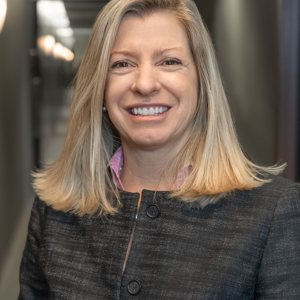What is Obsessive Compulsive Disorder (OCD)?
According to Laura Schuster Effland, Managing Director of Clinical Operations for Eating Recovery Center Washington, the psychiatric textbook definition of OCD requires the presentation of both uncontrollable, obsessive, recurrent thoughts (obsessions) and compulsive behaviors that must be repeated over and over again (compulsions).
Patients will often feel that the intrusive thoughts are the problem, and their compulsions are the solution. For example, if someone is experiencing intrusive thoughts about cleanliness or germs, their reaction can be to wash their hands, clothes and surroundings to an extent that it disrupts their usual way of living.
Dr. Charles Brady notes that when patients perform their compulsions, they’re trying to gain a sense of certainty and avoid or prevent the “what if” questions and feelings of uncertainty introduced by intrusive thinking. What if I drop and hurt this baby? What if I’m not as devoted to my religion as I ought to be? What if I just ran over a person while driving but I can’t tell?

Types of OCD
It’s important to remember that OCD can look different in different people, and this list won’t cover every possible manifestation of the disorder. However, some of most commonly occuring forms are identified as:
Harm obsession
This form of OCD is characterized by intrusive thoughts involving violent acts against another person, or fearing they could cause someone else harm. Compulsions often involve avoiding the risk of causing harm to others, like hiding/avoiding knives and sharp objects.
Perfection / Symmetry
Also known as “Just Right” OCD, this subset involves the need for things to be correctly aligned or symmetrical. Compulsions can include aligning, ordering, touching and tapping.
Checking Compulsions
As the name suggestions, this form of OCD presents with checking-based compulsive behavior. People with this OCD often believe that they could cause something bad to happen to themselves or others, creating anxiety. Compulsive checking is used to gain a sense of certainty that they did lock the door, turn off the oven, tuck their children in, etc.
Contamination / Cleanliness
Contamination OCD is characterized by a patient becoming concerned by illness or germs, or in some cases “clean eating.” Compulsions can include excessive washing or avoiding areas where it's more likely to come in contact with germs, like crowded public places.
Sexual OCD
Sexual obsession OCD, often under-diagnosed according to “Psychology Today,” involves unwanted thoughts of a sexual nature that those experiencing them find disturbing.
What Causes OCD (Obsessive Compulsive Disorder)?

Genetic & Inherited Factors
There is a notable genetic component to OCD, and it is not uncommon for family members to also have it.
Potential Genetic Component
The rate of heritability of OCD is reported to be between 35-50%, and the risk of developing OCD is greater in first-degree relatives, such as siblings or children, than compared to the general population.
Learning & Observed Behaviors
There is a theory that OCD compulsions and behaviors are learned over time.
Watching Family Members
Through watching family members avoid their fears or perform compulsive behaviors, it’s thought that others can pick up those habits and begin to perform them themselves.
Biology
Research suggests that OCD can take place in a brain that has chemical imbalances or in a brain that functions differently than other brains.
Chemical Imbalance
There is correlation between patients who experience OCD and those that have lower levels of serotonin. Serotonin is a chemical that acts as a neurotransmitter, and is involved in modulation of mood, cognition, memory and more.
Brain Functions
Studies have shown that certain areas of the brain — including the orbitofrontal cortex and anterior cingulate cortex — may be in higher use with people who experience OCD than those who don’t.
PANDAS
Pediatric Autoimmune Neuropsychiatric Disorders Associated with Streptococcal Infections (PANDAS) can be diagnosed when a child develops OCD or a tic disorder (sometimes both) after a strep infection. It is thought that the cause of the OCD occurs when autoimmune antibodies mistakenly attack part of the brain, the basal ganglia, rather than the infection.
Other Risk Factors
OCD can be related to a family history of having the disorder, or can be caused by specific events in your life.
Family History
Studies have shown that OCD is more commonly occurring among relatives of someone who experiences OCD than in relatives of people who don’t.
Stressful Life Events
A traumatic or stressful event can increase the risk of developing OCD. The event may trigger intrusive thoughts, compulsions or emotional distress.
OCD Symptoms & Signs
Obsessive compulsive disorder includes both obsessions and compulsions that take up a great deal of time. Signs and symptoms vary by age and individual, but treatment is possible.

OCD Obsession and Compulsion
Each subset of OCD can have its own symptoms, signs and triggers, but some of the most commonly occurring include:
Harm Obsession
Obsession
- Fear you will cause harm to others
- Fear of acting upon a violent urge
Compulsion
- Avoiding sharp objects
- Compulsively checking to ensure you haven’t caused anyone harm
- Asking others if you’ve hurt them
Perfection/Symmetry
Obsession
- Fixating on the feeling that something is “off”
- Ensuring symmetry in actions or their surroundings
Compulsion
- Repeating an action, such a flipping a light switch, until they have the feeling of “just right”
- Ordering, aligning and organizing that which is out of order
Checking Compulsions
Obsession
- Fear or doubt that lights were turned off, doors were closed, etc
Compulsion
- Repeated “checking” to make sure things are as you thought
- Seeking assurance from others
Contamination/ Cleanliness
Obsession
- Fear of germs, fluids, or touching certain items that may be contaminated
- Fear of spreading contaminants
Compulsion
- Repeated washing of hands
- Extensive bathing routines
- Avoiding public places and touching people
Sexual OCD
Obsession
- Fear around intrusive thoughts inconsistent with your sexual identity
- Thoughts about forcing someone else do perform a sexual act
Compulsion
- Avoiding interactions with people
- Self-punishing thinking
Obsession Symptoms
Obsessions are thoughts, images or impulses that occur over and over again and feel outside of a person’s control. Typically, people do not want these thoughts and even realize they don’t make sense. Obsessions often bring fear, doubt, and a consuming need to do things the “right way.” Common obsession symptoms include:
Fear of Contamination
When a person is overly concerned by illness or germs, they may be struggling with contamination OCD. Worry over touching items that may be contaminated, as well as a fear of spreading contamination, are prevalent with this fear. Concern over cleanliness may lead to avoiding social situations that could trigger anxiety.
Unwanted and Intrusive Thoughts
Thoughts take many forms. In the case of OCD, thoughts are distressing and usually follow a theme, such as doubt that tasks were done correctly, such as turning off the oven or locking doors. Other examples include:
- Needing things to be orderly or symmetrical, and feeling intense stress when objects are not a certain way
- Aggressive or horrific thoughts about losing control and harming themself or others
- Unwanted thoughts about aggression, sexual or religious subjects
Compulsion Symptoms
To neutralize the intensity of ruminations, people with OCD use compulsive, repetitive behaviors or thoughts as a temporary solution. Important to note is that they would rather not have to do these time-consuming tasks but feel driven to engage in compulsive behavior. Typical compulsions include:
Excessive Hand-washing
Intrusive thoughts create uncertainty, thus causing the need to perform a stress-reducing action. For those afraid of contamination, this often means excessive washing and cleaning of both themselves and objects around them. The repetitive washing of body and hands goes well beyond cleanliness and can cause skin to become chapped, raw or bleed.
“Checking” of Locks, Stove, etc.
Individuals with OCD often worry that harm will come to themselves or others. To ease these feelings, as well as ease the fear that they have forgotten to complete a task in order to keep everyone safe, they may compulsively perform many actions, including:
- Checking stove, doors repeatedly
- Counting in patterns
- Arranging items until it “feels right”
- Mental review of events/praying to prevent harm
- Repeating routine activities
OCD Signs in Children and Teens
The signs and symptoms of OCD in children and teens mimic those of adults, but often children and teens do not realize their obsessions and compulsions are out of the ordinary. Symptoms appear gradually over time, but there are signs to watch for:
Early-age Rituals
Rituals are important for child development, such as having an established eating or sleeping schedule. However, rituals can be problematic when children or adolescents become obsessed with doing them the “right way” and cannot complete tasks or move on until they’ve repeated the ritual to perceived perfection.
Counting
Like adults, children and adolescents with OCD often have the compulsive need to count. Homework may take hours as they rewrite the same number or word to get it “just right.” Similarly, they may be consumed by patterns and ordering objects a certain way.
Intense Need for Reassurance
As thoughts become distressing, children and adolescents may reach out to parents for reassurance — checking if doors are locked, windows closed, etc. — and keep asking until discomfort is relieved, and they feel confident nothing bad will happen. Though harmless once in a while, this need for reassurance is often not satiated and questions are repeated over and over.
Health Risks of OCD
When a person doesn’t know they have obsessive compulsive disorder (OCD) or they don’t know about methods of managing it — like forms of therapy and medication — there can be both emotional and physical OCD health risks. If left untreated, these complications can impact life in the long term.

Changes in Mental Health and Mood
With much time and energy focused on ritualistic behaviors, mental health and moods may suffer. Individuals living with OCD may experience significant emotional distress, difficulty developing and maintaining relationships, difficulty attending school and work, and an overall poorer quality of life due to the time it takes to perform rituals.
Depression
According to the International OCD Foundation, one quarter to one half of people with OCD also meet diagnostic criteria for a major depressive episode. OCD steals time from relationships, hobbies, school or work, and general life activities. When coping with OCD and depression, it can be increasingly difficult for patients to find the courage to seek treatment.
Anxiety
According to a 2020 peer-reviewed article, about 90% of people with OCD will also have anxiety disorders, mood disorders, impulse disorders, substance use disorders or other psychiatric conditions. Persistent, distressing thoughts and urges from OCD cause nerves to rise. As a person fights to control their mind and actions, anxiety increases.
Physical and Behavioral Effects
Beyond the mental health effects, those with OCD are at risk for behavioral effects, such as substance abuse and loss of sleep. These can lead to troubled relationships and an overall lessened quality of life.
Risk of Substance Abuse
With OCD and substance use alike, a person frequently completes an action (compulsion or using a substance) to temporarily find release. Unfortunately, once the effects wear off, the desire to do the action again intensifies. In addition to the similarities between OCD and substance use, social isolation and mental health effects from OCD can lead to seeking an escape in the form of alcohol or drugs.
Exhaustion and Loss of Sleep
Physical harm can occur as a result of compulsions, including contact dermatitis, repetitive strain injury, physical exhaustion; or from self-soothing behaviors, including biting nails, picking skin or pulling hair. The obsessions and compulsions may make it difficult to fall asleep until all rituals are completed, causing a lack of sleep and further exhaustion.
Long-Term Impacts of Untreated OCD
If OCD is left untreated, triggers may increase and make life difficult to manage. Due to time spent avoiding these triggers, isolation from friends and family is increasingly likely.
Disruptive Avoidance of Triggers
Without therapy and/or medication, obsessive thoughts and compulsions can make it extremely difficult to concentrate. Hours spent on compulsions, or avoiding triggers, can lead to missing out on life’s joys with loved ones. People who struggle with OCD commonly avoid:
- Going outside
- Social gatherings or celebrations
- Seeing family and friends
- Work or school
- Hobbies
Isolation From Friends and Family
With hours spent ruminating and acting to avoid fears, a person may become isolated from friends and family. To cope with this, compulsions to avoid further hurt or fear increase, taking up more time. Unfortunately, this can lead to sufferers feeling that they are alone.
At Pathlight Mood & Anxiety Center (Pathlight), our goal is to walk with patients every step of the way, so they know they are never on their own as they pursue recovery.
OCD Treatment
Obsessive compulsive disorder (OCD) can be managed with a combination of therapy and medication. Treatment helps ease emotional and physical complications of the disorder, so individuals can get back to living a fulfilling life.

Get matched with the exact support you need.
With one conversation, our mental health professionals will help you better understand what you’re going through and what you need.
We will meet you where you are, listen to your story in a therapeutic setting, and match you with the level of support that meets your struggle.
Therapy
While medication is helpful for managing symptoms, therapy is often an essential component for recovery from OCD. The following are proven methods to manage OCD so it does not control a person’s life:
Cognitive Behavioral Therapy (CBT)
Cognitive behavioral therapy is rooted in the idea that our thoughts, feelings, and behaviors are interrelated. In other words, our thoughts can influence behaviors, our behaviors can influence emotions, emotions can influence thoughts, and so on. There are two main components of CBT: cognitive change methods (exploring how thoughts and beliefs influence our emotions) and behavior change methods (looking at how our behaviors in situations can trigger or perpetuate symptoms).
CBT provides patients with the awareness and skills to identify and modify dysfunctional thoughts, emotions and behaviors that are causing them pain or interfering with their quality of life. Once unhelpful or distressing thoughts and behaviors are identified, patients can begin to make changes to their previous assumptions, thinking styles and behavioral responses.
Exposure & Response Prevention (ERP)
Exposure & Response Prevention is an evidence-based therapeutic intervention designed to help people safely confront their fears and interrupt patterns of avoidance and anxiety. Patients are supported by trained therapists throughout the exposures. Exposure work has been found to reduce emotional distress and improve overall functioning.
OCD Treatment Options with Pathlight
Treatments for OCD vary, but patients seeking help through Pathlight Mood & Anxiety Center (Pathlight) can find hope in recovery in our Residential and Partial Hospitalization Programs.
The OCD track is focused on supporting patients in managing triggers and experiencing success. It utilizes a specific form of Cognitive Behavioral Therapy called Exposure & Response Prevention (ERP) — an evidence-based treatment for OCD and other anxiety disorders. The specialty track includes OCD individual and group therapy, family therapy for ongoing support and education, and psychiatric assessments to modify OCD treatment plans.
With guidance from Pathlight's highly experienced therapists, patients learn and practice CBT skills, making gradual, systematic and sustained progress towards recovery from mood and anxiety concerns.
OCD Facts and Statistics
- Although OCD symptoms can begin in childhood (approximately ¼ of cases start by age 14), the average age of onset is 20. [1] DSMV reference
- OCD symptoms tend to show up earlier for males compared to females. 1
- Common obsessions associated with OCD include:
- Germ or contamination fears
- Fear of losing control over one’s actions, thoughts or behaviors.
- Forbidden, taboo or unwanted thoughts, often related to religion, sex or violence
- Fear that one will forget or lose something
- Obsession with symmetry, order or neatness[1]
- Common compulsions seen with OCD include:
- Mental acts that may not be observable (e.g., counting or repeating words silently)
- The need to have things in a specific order or arrangement
- Cleaning excessively
- Excessive handwashing
- Checking of items (garage door being closed, front door being locked, stove being turned off)
- Counting items[1]
- Studies of the brain show that people with OCD have differences in certain structures of the brain, including the frontal cortex and subcortical structures, along with communication problems between these areas. These brain regions are related to the ability to control one’s emotional and behavior responses.[1]
- A streptococcal infection may bring on a sudden onset of OCD symptoms in children related to Pediatric Autoimmune Neuropsychiatric Disorders Associated with Streptococcal Infections (PANDAS).[1]
- Psychotherapy treatment options for OCD including a specific form of cognitive behavioral therapy (CBT) called Exposure and Response Prevention, can be as effective as medication treatment. [1]
- Childhood trauma, including child abuse, has been linked to OCD.[2]
- Having a parent or close relative with OCD increases one’s risk of also having OCD.[2]
References
[1] National Institute of Mental Health: Obsessive-Compulsive Disorder: When Unwanted Thoughts or Repetitive Behaviors Take Over. Accessed December 2, 2022.
[2] MedlinePlus: Obsessive-Compulsive Disorder. Accessed December 2, 2022.
OCD FAQs
Is OCD anxiety?
Obsessive-compulsive disorder (OCD) was considered an anxiety disorder in the past. Today, OCD is classified in the category of “Obsessive-Compulsive and Related Disorders” in the Diagnostic and Statistical Manual of Mental Disorders (DSM-V-TR) along with:
- Body dysmorphic disorder
- Trichotillomania (hair-pulling disorder)
- Hoarding disorder
- Excoriation (skin-picking) disorder
What is OCD?
Obsessive-compulsive disorder (OCD) is a mental health condition that includes uncontrollable, obsessive, recurrent thoughts (obsessions) and compulsive behaviors that must be repeated over and over again (compulsions). OCD can look different for different people, but it often impacts people’s relationships, schoolwork, careers and overall health.
How can you tell if you have OCD?
Obsessive, recurrent thoughts (obsessions) and compulsive behaviors that must be repeated over and over again (compulsions) are signs of OCD. Learn more about specific OCD symptoms and take our brief self-assessment OCD test.
Can OCD be cured?
Cognitive Behavioral Therapy (CBT) and Exposure & Response Prevention (ERP) reduce distress associated with obsessive-compulsive disorder (OCD). For long-lasting relief, consider regular therapy sessions with a mental health professional specializing in OCD. Medication treatment may also help. Without treatment, OCD can become chronic and interfere with school, work or relationships.
When does OCD usually develop?
According to the International OCD Foundation, obsessive-compulsive disorder (OCD) symptoms can start in childhood or adulthood. Most people develop OCD symptoms between age 8-12, in their late teens, or in early adulthood.
Is there a test for OCD?
While no blood test or physical test exists to diagnose obsessive-compulsive disorder (OCD), mental health practitioners do offer screenings for OCD based on the criteria found in the Diagnostic and Statistical Manual of Mental Disorders (DSM-V-TR). Find a brief OCD self-assessment test.
How does OCD develop?
There is no single cause of obsessive-compulsive disorder (OCD). However, genetics, brain chemistry and external factors all play a role, including:
- Heredity/family history
- Learned and observed behaviors
- Chemical imbalance
- Brain functions
- Pediatric Autoimmune Neuropsychiatric Disorders Associated with Streptococcal Infections (PANDAS)
- Stressful life events/traumas
What happens if you leave OCD untreated?
Without treatment, obsessive-compulsive disorder (OCD) can get worse, increasing one’s emotional distress and affecting relationships, school and work. As one’s obsessions and compulsions worsen, individuals face an increased risk for anxiety, depression, substance use, sleep troubles, isolation and more.
Why do people get OCD?
The causes of OCD are not entirely clear, but research suggests the following can be contributing factors:
- Genetics
- Brain chemistry or abnormalities
- Life events or external stressors





